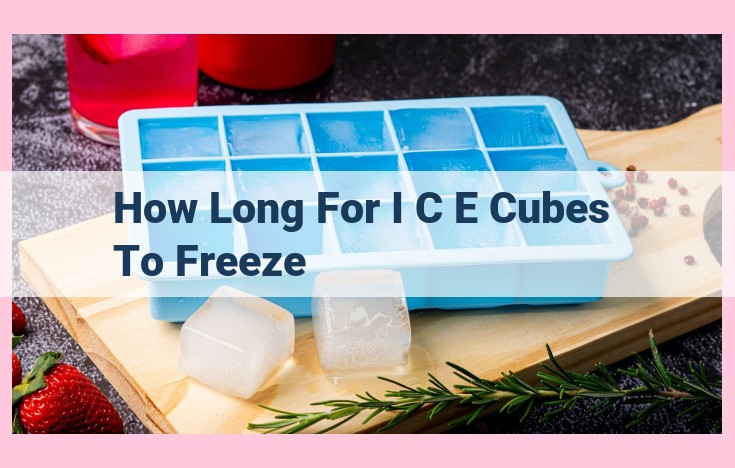Freezing Time Of Ice Cubes: Factors, Variations, And Optimization Techniques

The time it takes for ice cubes to freeze depends on several factors: freezer conditions (temperature, type, capacity, usage, defrost cycle), water quality (initial temperature, purity, additives), ice cube mold volume, and environmental conditions (altitude, humidity, ambient temperature). In general, it takes around 4-6 hours for ice cubes to freeze in a standard home freezer (-18°C or 0°F). However, this time can vary depending on the specific conditions. For example, smaller ice cubes will freeze faster than larger ones and a freezer that is heavily used or has a defrost cycle may take longer to freeze ice cubes.
Factors Influencing Ice Formation: Unraveling the Mysteries of Freezer Conditions
Ice, a seemingly simple element, holds a treasure trove of scientific intricacies. Its formation in freezers is influenced by a symphony of factors, and understanding these factors is crucial for optimizing ice production. Enter the freezer, a cold sanctuary where ice cubes take shape, influenced by a constellation of conditions.
Temperature: The heart of the ice-making process lies in temperature. Colder freezers facilitate faster ice formation. Every degree Celsius drop accelerates ice formation, making low-temperature freezers the ice-cube champions.
Freezer Type: Freezers don’t exist in a one-size-fits-all mold. Chest freezers, with their top-loading design, maintain colder temperatures due to minimal air exchange. Upright freezers, on the other hand, are more susceptible to warmer air infiltration, slowing down ice formation.
Capacity: Capacity, the freezer’s storage prowess, plays a pivotal role. Larger freezers often maintain more stable temperatures, ensuring consistent ice formation. Conversely, smaller freezers, battling temperature fluctuations, struggle to keep up with ice demands.
Usage Patterns: Usage patterns are the heartbeat of a freezer. Frequent door openings unleash a surge of warm air, disrupting the cold equilibrium. Defrost Cycles Break the ice-making rhythm, temporarily raising freezer temperatures. These interruptions, though necessary, can extend ice formation time.
By comprehending these freezer conditions, you gain the power to harness the ice-making capabilities of your appliance. Armed with this knowledge, you can create an icy paradise, effortlessly satisfying your frozen cravings.
Water Quality and Ice Cube Delights: Unlocking the Secrets of Crystal Clarity
The purity and quality of your water play a pivotal role in shaping the character of your ice cubes. Initial water temperature casts its spell, with colder water yielding harder and clearer ice. This is where purity steps in. Impurities like minerals or chlorine can cloud your ice, affecting its allure. Even the subtlest additives, such as fruit juice or herbs, embark on a transformative journey, bestowing unique flavors and hues upon your ice cubes.
Ice cube mold volume serves as a master puppeteer, orchestrating the size and shape of your frozen treasures. Smaller molds produce petite ice cubes, ideal for dainty cocktails and chilled treats. Larger molds, on the other hand, summon forth substantial cubes that promise a slower, more satisfying melt. The choice lies in your hands, guided by the vision you hold for your icy creations.
Environmental Influences on Ice Formation
Have you ever noticed how long it takes ice cubes to form in your freezer? Did you know that the environment around your freezer can affect how quickly or slowly your ice forms?
Three key environmental factors that influence ice formation are:
-
Altitude: At higher altitudes, the air is less dense, which means there is less resistance for water vapor to escape from the surface of the water. This allows water to evaporate more quickly, which in turn slows down the freezing process.
-
Humidity: Humidity refers to the amount of water vapor in the air. When the air is humid, there is more water vapor available to freeze, so the ice formation process is accelerated.
-
Ambient Temperature: The temperature of the air surrounding your freezer also affects ice formation. Warmer air holds more water vapor than cold air, so ice cubes will form more slowly in warmer environments.
By understanding how these environmental factors affect ice formation, you can adjust your expectations and plan accordingly!
Unit Measurements: Quantifying the Chilly Process
In our quest to freeze water into perfect ice cubes, we must equip ourselves with the proper units of measurement to accurately gauge the factors influencing this icy transformation. Time and temperature, the two crucial elements in ice formation, demand precise units to convey their values.
For ice formation time, minutes or hours serve as the recommended unit. Minutes provide a more granular measurement for shorter durations, while hours are more suitable for extended periods. By reporting time in these units, we establish a common language that facilitates comparison and analysis.
Temperature, on the other hand, is best expressed in degrees Fahrenheit (°F) or degrees Celsius (°C). These units provide a standard scale that allows for accurate measurement and comparison of temperatures across different environments. For consistency, it’s recommended to stick to one temperature unit throughout the discussion and clearly indicate the unit used to avoid confusion.
Adopting these recommended units ensures clarity and precision in reporting ice formation time and temperature. By using the appropriate units, we create a common ground for understanding and effectively communicate the factors that shape the icy metamorphosis from water to solid crystals.